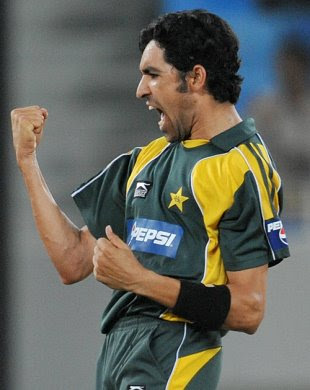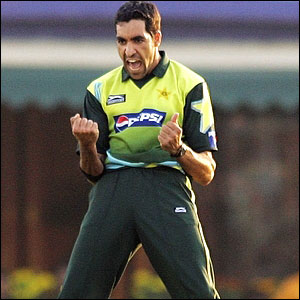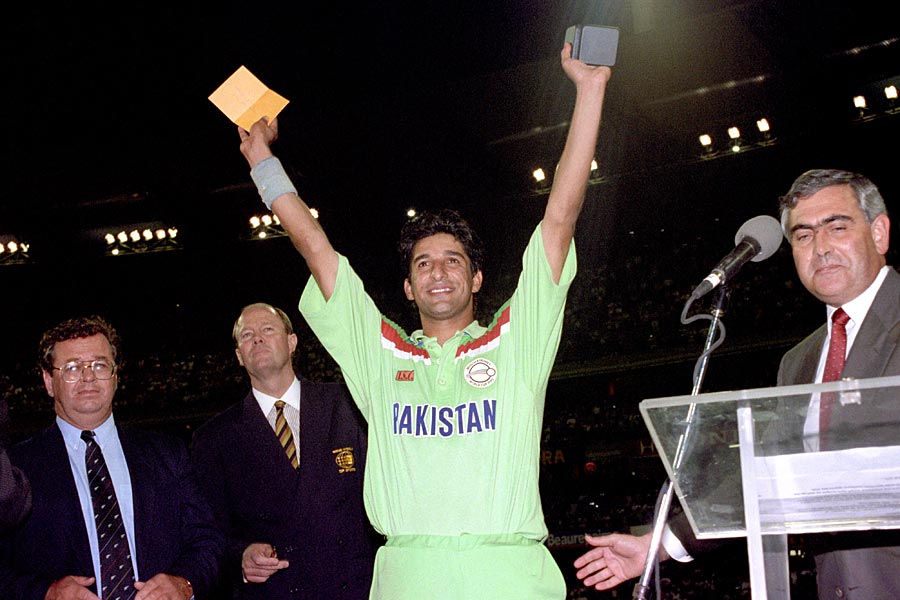Umar Gul Biography
Source(google.com.pk)
Contents [hide]
1 Personal life
2 Career
2.1 Early career
2.2 Test matches
2.3 Twenty20
2.4 One Day Internationals
2.5 Batting-skills
2.6 Injuries
3 Five-wicket hauls
3.1 ODI Five-wicket hauls
3.2 Twenty20 International five-wicket hauls
3.3 Test cricket Five-wicket hauls
4 References
5 External links
Personal life
Gul was born in
the Khyber-Pakhtunkhwa province of Pakistan he was born in a
middle-class family and frequently played tape-ball cricket. People on
the street encouraged Gul to become an international cricketer as they
saw his superb bowling. On October 2010 Gul's family announced that he
was to wed a Dubai Doctor. The doctor is from the Khyber-Pakhtunkhwa
province and she was born there as well.[5][6][7] On 30 May 2012,
Pakistan Army raided Umar Gul's house in Peshawar and arrested his
brother on the charge of hiding a wanted militant.[8]
Career
Early career
Gul was first
called up for the team in April 2003, playing four one-day matches at
the Cherry Blossom Sharjah Cup against Zimbabwe, Kenya and Sri Lanka,[9]
where he took four wickets, and he was in and out of the one-day team
after that tournament. However, he played the whole of the 2003–04 home
series against Bangladesh, making his Test debut and taking 15 wickets
in the three Tests, and took the second-most wickets of any Pakistani
bowler in the series, behind Shabbir Ahmed with 17. However, Shoaib
Akhtar, who took 13 in third place, only played two of the Tests.
Gul was
retained for the ODIs against Bangladesh, taking a List A best five for
17 in nine overs in the third match, and ended with 11 wickets in the
5–0 series win. However, he could still not command a regular spot,
playing three of Pakistan's nine next ODIs before finally getting
dropped after one for 36 against New Zealand.
Test matches
He was recalled
and played two Tests after that taking four wickets in a drawn Test
against New Zealand before coming in as replacement for Shabbir Ahmed in
the second Test of the three-Test series against India. After coming on
as first-change bowler, Gul dismissed Virender Sehwag in his second
over, and then bowled unchanged for 12 overs either side of lunch to
take five Indian top order wickets - including Rahul Dravid and Sachin
Tendulkar, who both had Test batting averages above 50, as did Sehwag.
Gul finished with five for 31 in his spell, earning him commendation
from Cricinfo journalist Dileep Premachandran, who praised his "control
of line and length",[10] and he was also named Man of the Match despite
conceding runs at five an over in the second innings in a nine-wicket
win.
After a length
injury lay-off, which kept him out of international cricket for nearly
two years, Gul returned to the Pakistan fold in 2006. Firstly with quiet
away series against Sri Lanka then followed by a tour to England in
2006. Gul was quickly made the lead bowler in the side due to the
injuries to other front line bowlers. Gul to 18 wickets in four tests,
justifying the selectors faith in him.
Later in 2006,
against West Indies at home, Gul had perhaps his most successful test
series. He took 16 wickets in 3 tests, including notable spells of
reverse swing bowling. He was responsible for breaking Ramnaresh
Sarwan's toe with a dipping yorker.
Test appearances however remained few and far between due to injuries and lack of test cricket for Pakistan.
In February 2009, Gul recorded his best test figures in the Pakistan team, taking 6 for 135 on an otherwise flat pitch.
In July 2010,
Pakistan faced England at Trent Bridge and were 147/9 in their first
innings. Gul scored 30* before the day was called off due to bad light.
He returned the next day with Mohammad Asif and batted with intent to
add another 35 runs in five overs. This saw Pakistan avoid the follow-on
against England and therefore survive an innings defeat.[11]
Gul then
suffered a hamstring injury in the second test when he was touring
England in 2010 he was ruled out for three weeks that meant he would
miss the remaining two tests. However Gul managed to recover and became
fit enough to play in the fourth test[12] However they decided to rest
Gul for the final test match despite the fact that he had recovered
quicker than expected.
His next chance
to play test cricket came against South Africa in November 2010 when he
took 3 wickets in a first innings and triggered a South African
collapse of 380 on a flat wicket. He took the crucial wicket with an
excellent inswinger against AB de Villiers[13]
Twenty20
With injuries
limiting Gul's test cricket participation, he made a distinct change to
his bowling set-up. Making a focus on bowling in the late overs of T20.
He got his opportunity with the absence of Shoaib Akhtar and Abdul
Razzaq in the 2007 ICC World Twenty20 held in South Africa. He was
generally used by Pakistan from the 13th over onwards and finished the
tournament with 13 wickets, making him the leading wicket taker ahead of
Shahid Afridi and RP Singh.
In the 2009 ICC
World Twenty20, he performed excellently, earning the mantle from at
least one pundit of "the outstanding seam bowler of the World
Twenty20".[14] His five-wicket haul for just six runs when Pakistan
dismantled New Zealand won especial acclaim. The spell made him the
first bowler in history to take a five wickets in a Twenty20
international, and he held the record of best T20I bowling figures until
8 August 2011, when surpassed by Ajantha Mendis (6/16).[15] Mutterings
were made about a possible correlation between ball tampering and the
exorbitant amounts of reverse-swing he was able to extract, but he
denied them categorically: "Whenever an Asian bowler performs and uses
the reverse-swing, the Western cricketing countries raise the issue of
ball-tampering against them."[16]
He was also
part of the Pakistan team that lifted the trophy at Lord's while also
finishing as the leading wicket taker of the tournament for the second
consecutive time.[17]
He gained a lot
of wickets bowled, in particular with late reverse swinging yorkers,
which dip late to slide under the bat and leave little room for batsmen
to maneuver the ball. Consequently he has also an excellent economy rate
in this format of the game.
In February
2008, Gul signed with the Indian Premier League and was drafted by
Shahrukh Khan's Kolkata Knight Riders franchise for US $150,000.[18] He
played in six matches, taking 12 wickets at an average of 15.33,[19]
including a player of the match award in Kolkata's final game in which
Gul took 4-23 and scored 24 runs from 11 balls.[20]
In December
2008 Gul signed with the Western Warriors to compete in the Australian
domestic 2008-09 KFC Twenty20 Big Bash tournament.[21] He performed very
well in his debut match for the Warriors, taking 4 wickets for 15 runs
in a losing side. He was amongst the most successful bowlers in the
competition despite not being available for the entire tournament he
finished second top wicket taker with 12 wickets.[22]
Internationally,
Gul has taken 47 wickets in just 32 games at an average of 14.65, a
truly outstanding statistic. He is the second leading wicket-taker in
Twenty20 Internationals behind teammate Shahid Afridi
One Day Internationals
Gul appeared in
all three of Pakistan's group matches in the 2007 World Cup taking four
wickets with an economy rate of 3.13, only Shane Bond of those to
deliver 100 balls was more economical.[23] He also appeared in all of
Pakistan's matches at the 2007 ICC World Twenty20 taking 3/15 of 4 overs
in the semi-final victory over New Zealand. He took three wickets in
the final to finish as the tournament's leading wicket-taker.[24]
Batting-skills
Despite the
fact that Gul is a bowler he can perform well as a lower order batsman
and has proved that he has the ability to score runs quickly he finest
moment with the bat came in a test match vs England in August 2010 when
Pakistan were at 103/7 and Gul came into bat he scored 29 of 30
deliveries when play was ended on that day however two more wickets had
fallen and the team were at 148/9 by night-time Pakistan would need 11
runs to avoid the follow-on. Gul then came and with his number 10
partner Mohammad Asif; Gul scored 34 runs in just 11 deliveries however
his partner Mohammad Asif was run out at the other end and Gul ended on
65*.
Injuries
However, Gul
was then ruled out of the third Test with a back injury which kept him
out of cricket for an entire year. He returned to play two games at the
2004–05 Faysal Bank T20 Cup, and played some matches for Pakistan A and a
Pakistan XI in warm-up games before the Test matches against England
the following season, but he was not selected for the matches and has
instead played three matches with Peshawar at the Quaid-e-Azam Trophy.
Gul had signed a
one year contract with Gloucestershire to play in 2007, but the
Pakistan Cricket Board failed to give them their permission.[25]
Shortly after
making a six-month come-back from a shoulder injury in July 2010 Gul
picked up a hamstring injury against England in August but it wasn't too
serious and he only missed the two Test matches.
Five-wicket hauls
Umar Gul
Umar Gul
Umar Gul
Umar Gul
Umar Gul
Umar Gul
Umar Gul
Umar Gul
Umar Gul
Umar Gul
Umar Gul
Umar Gul
Umar Gul
Umar Gul
Umar Gul
Umar Gul
Umar Gul
Umar Gul
Umar Gul
Umar Gul
Umar Gul
Umar Gul
Umar Gul
Shoaib Akhter Biography
source(google.com.pk)
Shoaib Akhtar, Cricketers is famous for Cricket, Pakistani celebrity. Born on 13 August, 1975
Shoaib Akhtar is a former Pakistani right arm fast bowler in cricket, who is regarded as the fastest bowler in the history of cricket. He set an official world record by achieving the fastest delivery, when he clocked in at 161.3 km/h (100.2 mph) in his bowling speed, twice at a cricket match against England. His ability to bowl fast yorkers and quick bouncers have made him one of the best fast bowlers in cricket.
However, he has been involved in several controversies during his career, often accused of not being a team player. Akhtar was sent home during the Test match series in Australia in 2005 for alleged poor attitude. A year later, he was embroiled in a drug scandal after testing positive to a banned substance. However, the ban imposed on him was lifted on court appeal. In September 2007, Akhtar was banned for an indefinite period for his fight with Pakistan team mate and fast bowler Mohammad Asif. On 1 April 2008, Akhtar was banned for five years for publicly criticizing the Pakistan Cricket Board. In October 2008, the Lahore High Court in Pakistan suspended the five year ban and Akhtar was selected in the 15-man squad for the Twenty20 Quadrangular Tournament in Canada. Pakistani judge, Rana Bhagwandas stated once that, Akhtar is a legend of Pakistan cricket. He retired from international cricket after the 2011 World Cup.
Early years
Akhtar was born at Morgah, a small town near Rawalpindi, Punjab in Pakistan. His father was a plant operator in Attock Oil Refinery, Morgah. Akhtar started his studies at Elliott High School, Morgah and then took admission in the Asghar Mall College, Rawalpindi.
Career
International career
Akhtar's run of impressive performances started in the 1990s. In 1999, during a pre-World Cup series against India, he rose to prominence. It was followed by outstanding bowling performances in Sharjah and later in 1999 Cricket World Cup. His most significant performance was in India in 1999 when he captured eight wickets in the Asian Test championship match at Calcutta – including the wickets of Indian batsman Sachin Tendulkar and Rahul Dravid off successive deliveries. This was Akhtar's first encounter with Sachin Tendulkar, in which Akthar bowled him off the first delivery he delivered to the batsman.
In 2002, he was selected for the Pakistan team against Australia and achieved success. However he performed poorly during the 2003 Cricket World Cup and after the tournament he was dropped from the Pakistan squad. He was selected back into the Pakistan squad in the 2004 Test match series against New Zealand, but struggled in a losing Test series against India in 2004. The series ended with a controversy when he left the field citing an injury leading to suspicions by former Pakistan captain, Inzamam-ul-Haq, about his commitment to the team. As a result, his relationship with Inzamam-ul-Haq and former Pakistan coach Bob Woolmer deteriorated. A medical panel was set up by the Pakistan Cricket Board to investigate the nature of his injury, however Pakistan officials dispelled all suspicions.
In 2005, Akhtar regained his reputation as a fast bowler for his side. Playing in a three Test home series against England, he made a series of impressive bowling performances. His effective use of slower deliveries proved to be unplayable by the English batsmen. Akhtar emerged as the highest wicket taker of the series with seventeen wickets. His comeback was also remarkable as prior to his return, he had been criticized from all corners-such as by the Worcestershire chairman John Elliot for his celebrity attitude and lack of commitment to team. His performance was also acknowledged by the English captain Michael Vaughan, who remarked "I thought he (Shoaib) was a big difference between the two teams". He is also known as the only bowler ever to break the 100 mph barrier in cricket bowling history, with a delivery of 100.2 mph, and this delivery at stands as the fastest recorded to date.
Struggle for form and consistent injuries (2007–2009)
On 29 October 2007, Akhtar made his return to cricket, from his 13 match ban and performed well, taking 4 wickets for 43 runs against South Africa in the fifth and deciding One Day International series in Lahore in Pakistan. Subsequently, he was included in the 16 man Pakistan squad for the 2007 tour of India, which he completed successfully without further incident and injury.
Rehabilitation and final years (2010–2011)
Akhtar made a return to international cricket albeit in the shorter format of the game. In May 2010, PCB named him in a list of 35 probables for the Asia Cup. On 15 June 2010, Akhtar made his return, taking 3 wickets for 28 runs in the first match of the Asia Cup against Sri Lanka. He narrowly missed out a spot in the 2010 ICC World Twenty20 in place of the injured Umar Gul.
In July 2010, he was selected for the Twenty20 series against Australia but the selectors decided not to play him in the Test squad so that he would not get injured. He was subsequently selected for the ODI and Twenty20 series against England in September 2010.
Akhtar returned to the national side representing the country against England in the Twenty20 International. He bowled an impressive spell and returned with figures of 2 wickets for 23 runs. He continued to bowl well in the ODI series in the absence of regular fast-bowlers, Mohammad Asif and Mohammad Amir, who were suspended by the International Cricket Council amid allegations of Spot-fixing. Despite his relatively good bowling form, Pakistani coach Waqar Younis insisted that the bowling attack must not become reliant on Akhtar, as he is 35 years of age and fitness troubles continue to affect him. Akhtar was selected for the tour of New Zealand and started his campaign off well with 3 wickets on Boxing Day in the first of two Twenty20 Internationals against New Zealand.
Akhtar was selected in Pakistan's 15-man squad to play in the 2011 World Cup hosted by Bangladesh, India, and Sri Lanka in February to march.During the tournament,he announced that he would retirefrom international cricket at the end of world cup cricket.
Shoaib Akhter
Shoaib Akhter
Shoaib Akhter
Shoaib Akhter
Shoaib Akhter\
Shoaib Akhter
Shoaib Akhter
Shoaib Akhter
Shoaib Akhter
Shoaib Akhter
Shoaib Akhter
Shoaib Akhter
Shoaib Akhter
Shoaib Akhter
Shoaib Akhter
Shoaib Akhter
Shoaib Akhter
Shoaib Akhter
Shoaib Akhter
Shoaib Akhter
Shoaib Akhter
Shoaib Akhter
Shoaib Akhter
Wasim Akram Biography
source(google.com.pk)
Full name Wasim Akram
Born June 3, 1966 Lahore, Punjab, Pakistan
Height 6 ft 2 in (1.88 m)
Role Bowler
Batting style Left-handed
Bowling style Left-arm fast
International information
Test debut (cap 102) 25 January 1985: v New Zealand
Last Test 9 January 2002: v Bangladesh
ODI debut (cap 53) 23 November 1984: v New Zealand
Last ODI 4 March 2003: v Zimbabwe
Domestic team information
Years Team
2003 Hampshire
2000/01 Lahore Blues
1992/93 – 2000/01 Pakistan International Airlines
1988 – 1998 Lancashire
1997/98 Lahore City
1985/86 Lahore City Whites
1984/85 – 1985/86 Pakistan Automobiles Corporation
Wasim Akram (Urdu: وسیم اکرم)(born June 3, 1966 in Lahore, Punjab) is a former Pakistani cricketer. He was a left-arm fast bowler and left-handed batsman, who represented the Pakistani cricket team in Tests and One-Day Internationals. He is widely regarded as one of the finest fast bowlers ever and holds world records for the most wickets taken in both ODIs (502) and List A cricket (881). Domestic career
Wasim signed for Lancashire in 1988 and went on to become one of their most successful overseas players. From 1988 to 1998, he spearheaded their attack in their NatWest Trophy, Benson & Hedges Cup and Sunday League winning sides. He was a favourite of the local fans who used to sing a song called "Wasim for England" at Lancashire's matches.
International career
Wasim made his Test debut for Pakistani cricket team against New Zealand in early 1985 and in only his second Test he made his presence felt with a ten-wicket haul. Like a few other Pakistani cricketers of his time, he was identified at club level and bypassed first-class domestic competition, entering international cricket directly. A few weeks prior to his selection into the Pakistani team, he was an unknown club cricketer who had failed to even make it to his college team. He was spotted by Javed Miandad, and as a result of his insisting was it that Wasim was given an oppurtunity to play for Pakistan. Later that season he paired with Imran, who became his mentor, at the World Championship of Cricket in Australia.
Wasim's rise in international cricket was rapid during the initial years. When Pakistan toured the West Indies in 1988, he looked to be the quickest bowler between the two sides. However, a serious groin injury impeded his career in the late 1980s. Following two surgeries, he re-emerged in 1990 as a bowler who focused more on swing and control than speed.
One-Day success
Wasim was instrumental in Pakistan's famous World Cup victory in 1992 in Australia. In the final against England his late flurry of an innings, 33 off 19 balls, pushed Pakistan to a respectable 249 for 6. Wasim then took the all-important wicket of Ian Botham early on, and when brought back into the attack later on, with the ball reverse swinging, he produced a devastating spell which led to Allan Lamb and Chris Lewis being clean-bowled in successive deliveries. His excellent performances earned him the Man of the Match award for the final.
He also captained Pakistan with some success. The high points of his captaincy were the 1996-97 victory in the World Series in Australia, two Test match wins in India in 1998-99 and in 1999, when Pakistan reached the World Cup final for the second time. The low point was the 1996 World Cup in Pakistan and India, when he had to pull out of the crucial quarter final match against India. After Pakistan's defeat, there were angry protests outside his homes, and a government inquiry was launched into the failure.
In 1999, he led Pakistan to the brink of victory in the World Cup before they rolled over and gave the final to Australia. This was the start of the match-fixing controversies, as people believed Wasim had set up the match for Australia. He was pardoned by Justice Qayyum.
He was Pakistan's top bowler in the 2003 World Cup taking 19 wickets in 7 matches. However, Pakistan failed to reach the "Super Six" phase of the tournament, and Wasim was one of the eight players to be sacked by the Pakistan Cricket Board as a result.
Wasim was diagnosed with diabetes at the peak of his career, but despite the initial psychological blow, he managed to regain his form and went on to produce fine cricketing displays. Since then he has actively sought to be involved in various awareness-raising campaigns for diabetes.
Playing style
“ Over my 15 or 16 years of playing international cricket in Tests and one-day internationals, Wasim Akram is definitely the most outstanding bowler I've ever faced. ”
— Former West Indies batsman Brian Lara.
An immensely talented player first discovered by Javed Miandad, Wasim played for his college(Govt. Islamia College Civil Lines, Lahore) as an opening bowler and batsman. As a bowler, Wasim possessed genuine pace, accurate control of line and length and seam position, and could swing the ball both in and out. With a very deceptive ball-concealing action, he could bowl equally well from both sides of the wicket. His mastery of reverse swing with the old ball meant he was at his most dangerous towards the end of an innings, and earned him the nickname Sultan of Swing.
As well as often being able to find the edge of the bat, Wasim would also focus his attack on the stumps and had a particularly lethal yorker. Of his 414 Test wickets, 193 were taken caught, 119 were taken LBW and 102 were bowled. In partnership with Waqar Younis, he intimidated international batsmen in the 1990s. Together Wasim and Waqar, known as "the two Ws" of the Pakistani team, were one of the most successful bowling partnerships ever.
Wasim was also skilled with the bat and was regarded as a bowling all-rounder. He was especially effective against spinners. However, he liked to slog and was criticised for his lack of big scores and giving away his wicket too cheaply for a player of his talent. He did silence his critics in October 1996 when he scored 257, not out, of the team's total of 553 against Zimbabwe at Sheikhupura. He also made good scores in difficult times for the Pakistan team such as his 123 against Australia and his 45 not-out to take Pakistan to victory in a low-scoring match. Pakistan, needing six runs in two balls two win the Nehru Cup saw Wasim come out to bat. The first ball he faced was hit out of the ground and secured the cup. Ahmed Bilal was his coach who gave him tricks on reverse swing.
Records
In his Test career, Wasim took 414 wickets in 104 matches, a Pakistani record, at an average of 23.62, and scored 2,898 runs, at an average of 22.64.
In One-Day Internationals, Wasim took a world record 502 wickets in 356 appearances, at an average of 23.52, and scored 3,717 runs, at an average of 16.52.
Wasim was the first bowler in international cricket to take more than 400 wickets in both forms of the game, and only Muttiah Muralitharan has since achieved this.
Wasim also held the record for the most wickets in Cricket World Cups — a total of 55 in 38 matches. Australia's Glenn McGrath broke the record during the 2007 World Cup, ending with a final tally of 71 from 39 matches. On passing Wasim's record, McGrath said, "Wasim Akram, to me, is one of the greatest bowlers of all time. Left-armer, swung it both ways with the new ball and he was so dangerous with the old ball. To go past him is something I will always remember. Probably the other side of the coin is that if you play long enough, you're going to break records here and there."
Uniquely, Wasim took four hat-tricks in international cricket, two each in Tests and ODIs. He is one of only three bowlers to have taken two Test hat-tricks (the others being Hugh Trumble and Jimmy Matthews), and also one of only three bowlers to have taken two ODI hat-tricks (the others being fellow Pakistani Saqlain Mushtaq and Chaminda Vaas of Sri Lanka). Wasim's Test hat-tricks are unique, since they were taken in consecutive Test matches in the same series, against Sri Lanka in 1999. Wasim is also one of only two bowlers to have taken both a Test and ODI hat-trick (the other being fellow Pakistani Mohammad Sami).
Playing in a Test against the West Indies at Lahore in 1990-91, he became one of only six players to have taken four wickets in an over during a Test match. In Wasim's case, the feat was not part of a hat-trick, the third ball of the series being a dropped catch, which allowed a single.
Wasim has also achieved the highest score by a number eight batsman in Test cricket — 257 not out from 363 balls against Zimbabwe at Sheikhupura. The innings contained 12 sixes which is also a world record for Test cricket.
He also has the joint-highest number of Man of the Match awards in Test cricket, along with South African Jacques Kallis, with 17.
Controversies
In 1992, after he had been successful against English batsmen, accusations of ball tampering began to appear in the English press, though no video evidence was ever found. Wasim and Waqar had been able to obtain prodigious amounts of movement from old balls. This phenomenon, termed reverse swing was relatively unknown in England at the time.
A far larger controversy was created when he was alleged to be involved in match fixing. An enquiry commission was set up by Pakistan Cricket Board headed by a Pakistan high court judge Malik Mohammed Qayyum. The judge wrote in his report that:
This commission feels that all is not well here and that Wasim Akram is not above board. He has not co-operated with this Commission. It is only by giving Wasim Akram the benefit of the doubt after Ata-ur-Rehman changed his testimony in suspicious circumstances that he has not been found guilty of match-fixing. He cannot be said to be above suspicion.
Retirement
Wasim retired in 2003, after a brief spell with Hampshire in England. Since then, Wasim has taken up commentary and can currently be seen as a sportscaster for the ESPN Star network, and is also running shows on ARY Digital.
He is married to Huma Mufti, daughter of Mr. Humayaun Mufti. Huma and Wasim have two sons from their marriage of thirteen years.
Wasim Akram
Wasim Akram
Wasim Akram
Wasim Akram
Wasim Akram
Wasim Akram
Wasim Akram
Wasim Akram
Wasim Akram
Wasim Akram
Wasim Akram
Wasim Akram
Wasim Akram
Wasim Akram
Wasim Akram
Wasim Akram
Wasim Akram
Wasim Akram
Wasim Akram
Wasim Akram
Wasim Akram
Wasim Akram
Wasim Akram
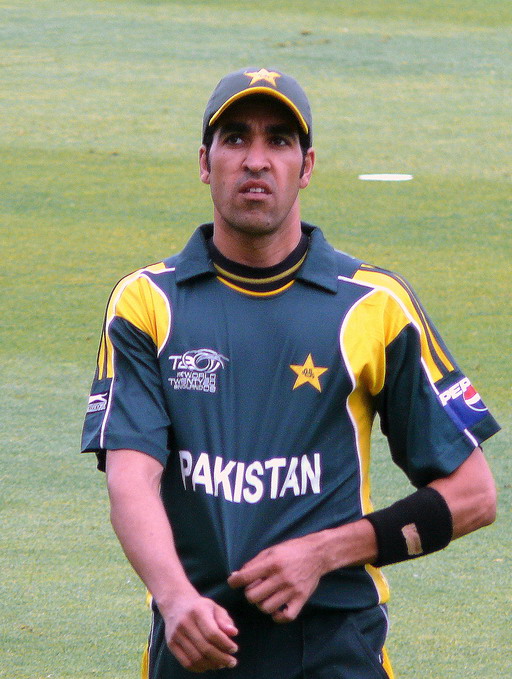

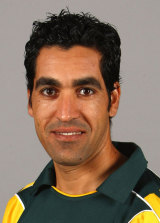

.jpg)



